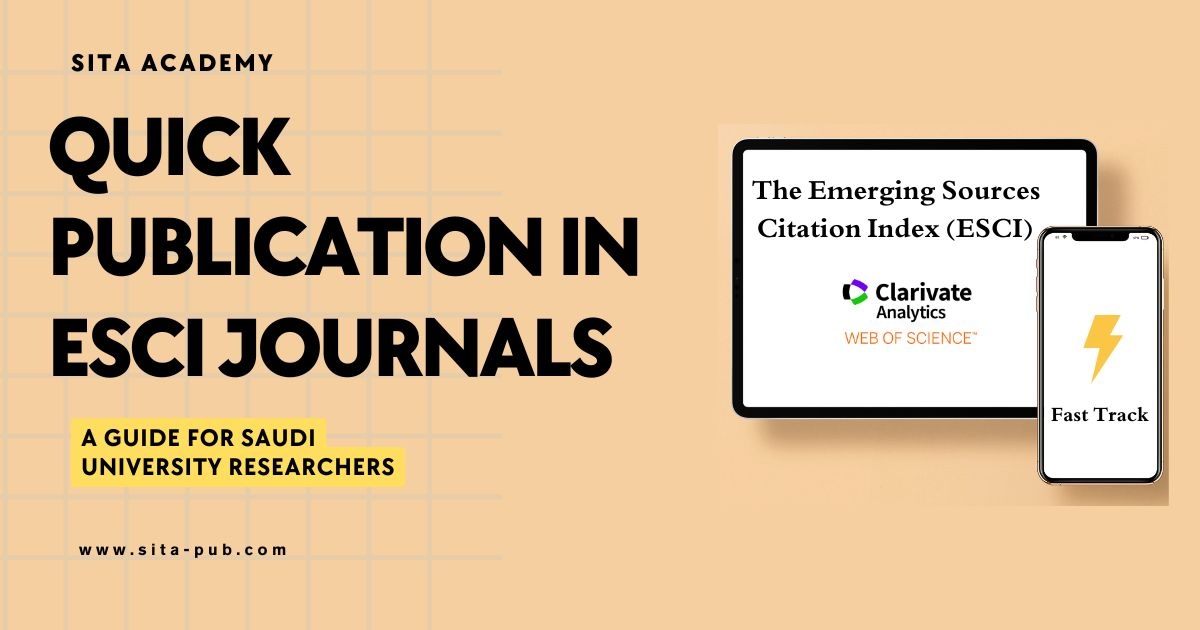Quick Publication in ESCI Journals


For many researchers in Saudi Arabia, publishing in reputable journals is a key requirement for academic promotion and career advancement. Traditionally, journals indexed in the Science Citation Index (SCI) or Social Science Citation Index (SSCI), which are part of Clarivate’s Web of Science (WoS), have been the preferred venues for academic publications. However, in recent years, the Emerging Sources Citation Index (ESCI) has gained recognition among Saudi universities as an acceptable and valuable category of journals for promotion purposes.
ESCI journals are known for maintaining good academic standards and often provide faster publication timelines compared to more established journals indexed in the Journal Citation Reports (JCR). This combination makes them especially attractive to faculty members who need to publish within tight deadlines for promotions or grant applications.
In this guide, we’ll explain what ESCI journals are, why many Saudi universities accept them, and how researchers can identify ESCI journals with fast publication options that best suit their needs.

The Emerging Sources Citation Index (ESCI) is a citation index introduced by Clarivate Analytics as part of the Web of Science Core Collection. It includes high-quality, peer-reviewed journals that are either new or cover emerging scientific fields and regional research topics. ESCI serves as a stepping stone for journals that are under evaluation for potential inclusion in the more prestigious Science Citation Index Expanded (SCIE) or Social Sciences Citation Index (SSCI).
ESCI journals are indexed in Web of Science, which means they are searchable alongside well-known indexed journals. Although ESCI journals do not yet have an official impact factor from the Journal Citation Reports (JCR), they are considered credible and are often used as a platform for researchers to publish their findings. Citation data from ESCI journals contribute to the overall calculation of impact factors in the Web of Science ecosystem.
Many universities in Saudi Arabia now recognize ESCI journals as valid venues for academic publication, particularly for faculty promotion and tenure. This recognition is driven by the expanding academic landscape and the need to acknowledge reputable research beyond only high-impact journals.

For example:
King Abdulaziz University (KAU) includes ESCI journals among its accepted publication venues for academic promotion, provided the journal meets quality standards.
King Fahd University of Petroleum & Minerals (KFUPM) considers ISI-listed journals, which includes ESCI journals indexed by Clarivate, as part of their faculty promotion criteria.
Prince Sultan University accepts publications in indexed journals, including ESCI, for various academic evaluations and promotion steps.
Umm Al-Qura University recognizes publications in ESCI-indexed journals as part of its faculty promotion requirements, acknowledging their growing academic value.
It is essential for researchers to review their specific university's promotion guidelines, as acceptance and weight given to ESCI journals may vary. However, the general trend is toward broader acceptance, especially for emerging disciplines and early-career researchers.
A key advantage of many ESCI journals is their typically faster peer review and publication process compared to traditional high-impact journals. Since ESCI journals are often newer or cover emerging topics, they aim to attract quality submissions by offering shorter timelines from submission to publication.
However, the speed of publication varies from journal to journal. Some may take several months, while others have implemented “fast-track” or “rapid review” options that can significantly reduce the waiting period. Here are some tips on how to identify ESCI journals with fast publication options:

Visit the Journal’s Website: Most journals list their average peer review times and publication timelines under the “For Authors” or “About the Journal” sections. Look specifically for mentions of “fast-track” or “rapid publication” services.
Check Recent Publication Dates: Review the dates on recently published articles in the journal to get a sense of how quickly papers move through the process.
Contact the Editorial Office: If no information is available online, email the journal editors or staff directly to ask about their average review and publication times, and whether they offer fast-track options.
Use Academic Networks and Forums: Sometimes other researchers can share insights on journals’ timelines based on their personal experience.
Using these methods, Saudi researchers can identify suitable ESCI journals that align with their need for timely publication.
Finding the right journal can be a challenging and time-consuming task. To help Saudi academics navigate this process, SITA Academy has curated a comprehensive and up-to-date list of ESCI journals known for their rapid publication options and acceptance by Saudi universities.
Our list is carefully matched to your specific research field, ensuring that you get recommendations most relevant to your work and institution’s criteria.
How to Get Your Customized List:
Email Us: Send your research topic or field to [email protected]
WhatsApp: Message us directly at https://wa.me/+905344998991
Once you provide your research scope, our team will respond within 24 hours with a tailored list of fast-track ESCI journals, including details about fees, publication timelines, and submission guidelines.
Publishing in ESCI journals presents an excellent opportunity for Saudi university researchers to meet academic promotion requirements while benefiting from potentially faster publication timelines. As ESCI journals gain wider acceptance, understanding how to select journals with rapid peer review options can help faculty members plan their submissions more strategically.